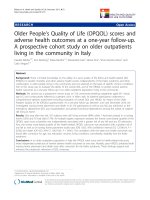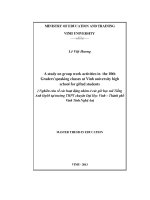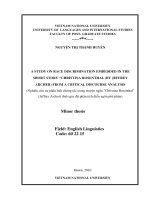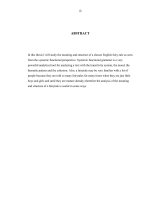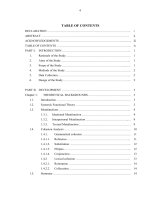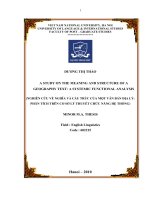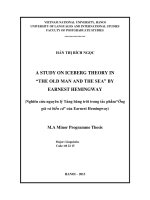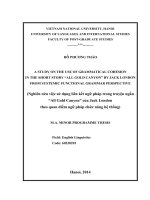a study on race discrimination embedded in the short story christina rosenthal by jeffrey archer) from a critical discourse analysis = nghiên cứu sự phân biệt chủng tộc trong truyện ngắn christina rosenthal
Bạn đang xem bản rút gọn của tài liệu. Xem và tải ngay bản đầy đủ của tài liệu tại đây (1.81 MB, 84 trang )
Vietnam National University
university of languages and international studies
Faculty of Post- graduate studies
-----***----NGUYỄN THỊ THANH HUYỀN
A study on RACE DISCRIMINATION EMBEDDED IN THE
SHORT STORY "CHRISTINA ROSENTHAL (BY JEFFREY
ARCHER) FROM A CRITICAL DISCOURSE ANALYSIS
(Nghiên cứu sự phân biệt chủng tộc trong truyện ngắn "Christina Rosenthal"
(Jeffrey Archer) dưới góc độ phân tích diễn ngôn phê phán)
Minor thesis
Field: English Linguistics
Code: 60 22 15
Hanoi, 2010
Vietnam National University
-2-
university of languages and international studies
Faculty of Post- graduate studies
-----***----NGUYỄN THỊ THANH HUYỀN
A study on RACE DISCRIMINATION EMBEDDED IN THE
SHORT STORY "CHRISTINA ROSENTHAL (BY JEFFREY
ARCHER) FROM A CRITICAL DISCOURSE ANALYSIS
(Nghiên cứu sự phân biệt chủng tộc trong truyện ngắn "Christina Rosenthal"
(Jeffrey Archer) dưới góc độ phân tích diễn ngơn phê phán)
Minor thesis
Field: English Linguistics
Code: 60 22 15
Supervisor: Prof. Nguyễn Hòa
Hanoi, 2010
DECLARATION
-6-
TABLE OF CONTENTS
DECLARATION.............................................................................................................
ACKNOWLEDGEMENTS............................................................................................
ABSTRACT....................................................................................................................
TABLE OF CONTENT..................................................................................................
LIST OF ABBREVIATIONS........................................................................................
LIST OF FIGURES, TABLES, AND CHARTS...........................................................
Part A: Introduction.....................................................................................................
1. Rationale....................................................................................................................
2.Significance of the study............................................................................................
3. Aims of the study and research questions..................................................................
4. Scope of the study......................................................................................................
5. Methodology of the study............................................................................................
6. Design of the study......................................................................................................
PART B: DEVELOPMENT.........................................................................................
CHAPTER 1: THEORETICAL BACKGROUND....................................................
1.1. Background to Critical Discourse Analysis.............................................................
1.1.1. CDA‟s definitions.................................................................................................
1.1.2. Key concepts of CDA............................................................................................
1.2. CDA theories and Practice.......................................................................................
1.2.1. Overview of the approaches to CDA.....................................................................
1.2.2. Three main schools of CDA..................................................................................
1.2.2.1. Van Dijk‟s school – Socio-cognitive approach..................................................
1.2.2.2. Ruth Wodak‟s school – The discourse – historical approach.............................
1.2.2.3. Fairclough‟s school – Systemic Functional Grammar.......................................
1.2.3. Fairclough‟s framework of CDA...........................................................................
1.3. Systemic functional grammar in CDA.....................................................................
1.4. Summary..................................................................................................................
CHAPTER 3: METHODOLOGY AND ANALYSIS PROCEDURES..................
2.1. About the object of the enquiry................................................................................
2.2. Some brief information about the story.................................................................
2.2.1. The story itself....................................................................................................
2.2.2. Context of the story............................................................................................
2.3. Data analysis procedure.........................................................................................
2.2. Analysis of discourse macrostructures of the story..................................................
2.3. Analysis of discourse microstructures of the story..................................................
2.3.1. The title: Christina Rosenthal................................................................................
2.3.2. Lexicalization........................................................................................................
2.3.2.1. Christina Rosenthal - who teased Benjamin and taunted him..........................
2.3.2.2. Christina Rosenthal - who teased Benjamin and taunted him.........................
2.3.2.3. Christina Rosenthal sacrificed her life for love................................................
2.3.2.4. Christina's death left a regret to her parents and the rabbi................................
2.3.3. Conversation structure..........................................................................................
2.3.3.1. Conversation between Benjamin and Christina.................................................
2.3.3.2. Conversation between Benjamin and Christina‟s father....................................
2.3.3.3. Conversation between Benjamin and Christina‟s mother .................................
2.3.4. Transitivity............................................................................................................
i
ii
iii
iv
vii
viii
1
1
2
2
2
2
3
4
4
4
4
4
5
5
5
5
6
6
7
11
13
14
14
15
15
15
16
17
19
19
21
21
22
24
24
26
27
30
31
31
-7-
2.3.4.1. Christina as a participant....................................................................................
2.3.4.2. Benjamin as a participant...................................................................................
2.3.4.3. The rabbi as a participant...................................................................................
2.3.4.4.Christina's parents as participants........................................................................
2.4. Summary..................................................................................................................
PART C: CONCLUSION............................................................................................
1. Summary of the findings............................................................................................
2. Conclusions................................................................................................................
3. Suggestions for further study......................................................................................
REFERENCES...............................................................................................................
APPENDIX 1.................................................................................................................
APPENDIX 2.................................................................................................................
APPENDIX 3................................................................................................................
32
34
35
36
36
37
37
38
39
40
I
II
IV
-8-
ABBREVIATIONS
CDA
Crtical Discourse Analysis
CL
Critical Linguistics
SFG
Systemic Functional Grammar
SFL
Systemic Functional Linguistics
MR
Member's Resource
sM
sub-Macroproposition
Dir
Directive
Ex
Expressive
Com
Commissive
Rep
Representative
Dec
Declarative
B
Benjamin
C
Christina
-9-
FIGURES, TABLES AND CHARTS
Line
FIGURE 1 Interpretation...................................................................................
9
FIGURE 2 Explanation......................................................................................
11
Summary of process typ.es ..............................................................
12
FIGURE 3 The macrostructure of the text...........................................................
18
TABLE 1
TABLE 2
Examples of the use of "Christina" in the story............................
19
TABLE 3
The number of words spoken by Christina and Benjamin ...........
27
CHART 1
Chart 1: The number of words spoken by Christina and Benjamin in 28
their conversations.......................................................................
TABLE 4
Summary of speech acts in the conversation between Christina and 28
Benjamin......................................................................................
CHART 2
Summary of speech acts in the conversation between Rosemary and 28
the girl..........................................................................................
FIGURE 4 Structural analysis of the assertive "She will never marry a 31
Jew".............................................................................................
TABLE 5
Participant types of the characters in the story............................
32
TABLE 6
Summary of the processes in which Benjamin is a participant....
32
TABLE 7
Material and Mental processes that Benjamin is engaged in........
33
TABLE 8
Summary of the processes in which Christina is a participant.....
34
TABLE 9
Summary of the processes in which the rabbi is a participant.....
35
- 10 -
PART A: INTRODUCTION
1. Rationale
Critical Discourse Analysis (CDA), as it was, is a relatively new research area in Vietnam,
which were introduced just about five years now. Interest in CDA is growing and
appealing to many. Thus, this study is another attempt aimed at enhancing the
consciousness of how power and ideology are embedded in language in particular, and the
relations between language and society in general. It then somehow brings the contribution
to applying CDA to doing linguistic research.
CDA has been drawing the attention of many researchers, both linguists and social analysts
since its introduction. Its applicability is considered in every context and every discipline.
Not only CDA is applied within disciplines such as humanities and sciences but also in
professional areas like medicine, environmental studies, engineering, social policy,
education, law, etc. CDA subsumes a variety of approaches towards the social analysis of
discourse which differ in theory, methodology, and the type of research issues to which
they tend to give prominence.
In contrast to other paradigms in discourse analysis and text linguistics, CDA focuses not
only on texts, spoken or written, as objects of inquiry but also on the social processes and
structures, which give rise to the production of a text, and of the social structures and
processes within which individuals or groups as social-historical subjects, create meanings
in their interaction with texts (Fairclough, 1993).
This is particularly the case for literature – one of the prominent types of discourse in
which the values, beliefs and ideologies of particular nations, social classes and social
groups could be represented through language. However, as it happens, literary discourse
has not been the object of CDA investigation, to the best of my knowledge. I have decided
to do the study on the short story: "Christina Rosenthal" by Jeffrey Archer from a CDA
perspective. The short story is so moving, so meaningful and comprehensive in terms of
race discrimination. In the thesis, I hope to be able to discover and analyse critically the
race discrimination hidden in the Canadian society of the time from such a story.
- 11 -
All of the above reasons have encouraged me to conduct the research entitled "A study on
race discrimination embedded in "Christina Rosenthal" by Jeffrey Archer from a critical
discourse analysis perspective."
2. Significance of the study
In fact, as CDA is quite a new research area in Vietnam, this study is aimed at enhancing
the consciousness of how power and ideology are embedded in language in particular, and
the relation between language and society in general. It can make some significant
contribution to applying CDA to doing linguistic research.
3. Aims of the study and research questions
3.1. To provide a CDA analysis of the short story: “Christina Rosenthal” from a new
perspective of discourse analysis. Through this study, readers can access how race
discrimination are represented lexically, grammatically and macro-structurally as well.
3.2. The research questions:
a. What kinds of power and social relations are expressed in the story?
b. How are these relations expressed?
c. How can they be explained and interpreted?
4. Scope of the study
- The CDA analysis of the short story “Christina Rosenthal” is confined to some
linguistic aspects and some features of context.
- Among some social issues, race discrimination is mainly dealt with in the study.
- The study is oriented to discover the linguistic aspects, not literary ones.
5. Methodology
"Language as a form of social practice" (Fairclough, 2001) is always being adhered strictly
throughout the study. "Christina Rosenthal", a literature work, is not going to be taken into
pieces but to be considered a system which is created by sub-systems. When analyzing a
- 12 -
particular lexical item, the writer will always put it in relation with other elements of its
sub-system and the whole system as well, with its macrostructures and its context.
The study bases itself on the common sense assumptions that there are “implicit
conventions according to which people interact linguistically” (Fairclough 2001).
Regarding the short story, there exists some aspects influencing the lexical and
grammatical choice of the writer. It then follows the inductive, that is all underlying
patterns and principles are drawn from description of data and generalization of findings.
The study is inclined to follow the integrated approaches; I try to conduct it through a
combination of some popular approaches in CDA (approaches of van Dijk, Fairclough,
Ruth Wodak). However, the greatest linguist I had influence when carrying out this thesis
is Halliday's systemic functional grammar.
In carrying out this study, I follow these procedures: At first, several approaches to CDA
are reviewed so that an appropriate theoretical framework suited to the aims and subject of
the study could be mapped out. The study is not based on a particular approach, rather, it is
drawn upon a combination of two most outstanding approaches proposed by two CDA
practitioners, Fairclough and van Dijk. Secondly, the discourse I chose is a short story
“Christina Rosenthal”, the analysis is done in two phases:
General textual description of the story is made in terms of lexis and syntax towards the
underlying ideology in the story.
The story is analyzed in terms of lexical and grammatical choice, conversation structure,
transitivity, and implicatures is to find out how ideology is linguistically realized. Later on,
this serves as the underpinning for the interpretation and explanation of the findings.
6. Design of the study
The study includes three main parts:
Part 1: Introduction discusses the rationale, significance, scope, aims, methodology and
design of the study
Part 2: Development. This part is divided into two chapters
- 13 -
Chapter 1: Theoretical background and Literature review presents a brief theoretical
background of Critical Discourse Analysis, Systemic Functional Grammar.
Chapter 2: Methodology and analysis procedures describes the data collection and the
procedure of analyzing data to detect the race discrimination embedded in the story and
discusses the findings of the analysis.
Part 3: Conclusion summarizes the major findings, provides concluding remarks and make
suggestions for further studies.
- 14 -
PART B: DEVELOPMENT
CHAPTER 1: THEORETICAL BACKGROUND
1.1. Background to Critical Discourse Analysis
1.1.1. CDA’s definition
According to van Dijk (1998a), CDA is a field that is concerned with studying and
analyzing written and spoken texts to reveal the discursive sources of power, dominance,
inequality and bias. It examines how these discursive sources are maintained and
reproduced within specific social, political and historical contexts.
In a similar vein, Fairclough (1993) defines CDA as discourse analysis which aims to
systematically explore often opaque relationships of causality and determination between
(a) discursive practices, events and texts, and (b) wider social and cultural structures,
relations and processes; to investigate how such practices, events and texts arise out of and
are ideologically shaped by relations of power and struggles over power (p. 135).
1.1.2. Key concepts of CDA
It is necessary to bring the explanation of one of the most controversial issues which is
subject to quite a lot of discussion among CDA and even non-CDA practitioners.
“Investigating language in relation to power and ideology” (Wodak and Meyer, 2001:6) is
the primary concern of CDA. According to van Dijk (1998), CDA is a field that is
concerned with studying and analyzing written and spoken texts to reveal the discursive
sources of power, dominance, inequality and bias. It examines how these discursive
sources are maintained and reproduced within specific social, political and historical
contexts. Moreover, the investigation is conducted by critical and historical view.
Therefore, the following concepts figure indispensably in CDA: critical, historical.
At first, „what is meant by critical approaches‟, Critical approaches mean to be critical of
the present social order. CDA is seen to be a means of criticizing the social order. Rather, it
is because it is rooted in a radical critique of social relations.
Secondly, CDA and critical approaches in general, distinguish themselves from other
whose theoretical and methodological assumptions seem to exclude direct political or
- 15 -
radical analyses. This advocated Fairclough in his claims that “critical approaches not just
describe discursive practices but also show how discourse is shaped by relations of power
and ideologies” (1992)
Why the term “historical” needs to be explained. "discourse … is always historical,
Wodak, 1996, p. 12) that is, it is connected synchronically and diachronically with other
communicative events which are happening at the same time or which have happened
before" (p. 12)
1.2. CDA theories and Practice
1.2.1. Overview of the approaches to CDA
CDA specifically considers more or less overt relations of struggle and conflict in society.
Even though CDA has just been developed for more than thirty years, it is built from the
considerable contribution of many linguists in terms of both theory and methodology
(Wodak & Meyer, 2001). It is comprehensible why there exist different approaches in
doing CDA.
1.2.2. Three main schools of CDA
1.2.2.1. Van Dijk’s school – Socio-cognitive approach
Among CDA practitioners, van Dijk is one of the most often referenced and quoted in
critical studies of media discourse, even in studies that do not necessarily fit within the
CDA perspective. By structural analysis, van Dijk posited analysis of "structures at various
levels of description" which meant not only the grammatical, phonological, morphological
and semantic level but also "higher level properties" such as coherence, overall themes and
topics of news stories and the whole schematic forms and rhetorical dimensions of texts.
1.2.2.2. Ruth Wodak’s school – The discourse – historical approach
Her research is mainly located in Discourse Studies and in Critical Discourse Analysis.
Ruth's research agenda focuses on the development of theoretical approaches in discourse
- 16 -
studies (combining ethnography, argumentation theory, rhetoric and functional systemic
linguistics); gender studies; language and/in politics; prejudice and discrimination.
1.2.2.3. Fairclough’s school – Systemic Functional Grammar
The third main approach in CDA is that of Fairclough whose theory has been central to
CDA over more than the past ten years. He described the objective of this approach as "a
contribution to the general raising of consciousness of exploitative social relations, through
focusing upon language" (1989, p. 4).
With CDA, Fairclough (1997, 271-9), has tackled the relationship between language and
context by elaborating on socially based topics such as: 'CDA addresses social problems';
'power relations are discursive'; 'discourse constitutes society and culture'; ' the link
between text and society is mediates'; and 'discourse is a form of action'
1.2.3. Fairclough’s framework of CDA
One of the most successful achievements in his pursuance of CDA by Fairclough is the
practical framework in which he distinguishes three stages (description, interpretation and
explanation) corresponding to the three dimensions of discourse: text, interactions and
context respectively.
-
Description is the stage which is concerned with the formal properties of the text.
-
Interpretation is concerned with the relationship between text and interaction with
seeing the text as the product of a process of production, and as a resource in the
process of interpretation.
-
Explanation is concerned with the relationship between interaction and social
context with the social determination of the processes of production and
interpretation, and their social effects.
(Fairclough: 2001: 21-22)
Description necessarily entails interpretation in the second phase as it provides the medium
for the real representation of textual features. Interpretation is made possible via a
combination of the textual features (the cues) and what is „in‟ the interpreter (or the
member‟s resource (MR) i.e. the background knowledge). In this regard, the interpretation
process can be described as a process in which the cues activate elements of the MR (such
- 17 -
as phonology, grammar, vocabulary, semantics, pragmatics, cohesion, etc.). As a means for
doing so, the MR is called interpretative procedures.
Figure 1: Interpretation
Interpretative procedures
(Fairclough, 2001: 119)
Resources
Interpreting
(MR)
Social orders
Interactional history
Phonology, grammar
Vocabulary
Situational context
Intertextual context
Surface of utterance
Semantics,
Pragmatics
Meanings of utterance
Cohesion
Pragmatics
Local coherence
Schemata
Text structure and point
Stage 2: Interpretation
Interpretation has its spotlight on the „discourse processes and their independence
background assumptions‟ (p117). According to the diagram, the interpretation is realized
in two levels, interpretation of texts (lower section and interpretation of content (upper
section). The interpretation of texts is further done in four phases (pp119-120):
- 18 -
Surface of utterance which relates to the process by which interprets convert strings of
sounds or marks into words, phrases and sentences. This requires the knowledge of
vocabulary, grammar and phonology.
Meaning of utterance has to do with attributing meanings to the constituent parts of a
text, which requires the knowledge of semantics and pragmatics.
Local coherence sets up meaning connections between utterances to make coherence.
The interpreter now has to draw upon their knowledge of cohesion.
Text structure and point is actually the insight into the global coherence. It involves
matching the text with one of a repertoire of schemata or representations of characteristic
patterns of organization associated with different type of discourse.
The interpretation of context consists of situational and intertextual contexts. The former is
done on the basis of external cues such as the features of the physical situation, properties
of participants and on aspects of their MR in terms of how they interpret these cues. The
latter bases on the assumptions about the previous discourse(s) to which the discourse in
question link with (international history).
The central part, containing boxes and arrows (single-headed or double headed) indicates
that interpretation is a flexible process: for example the "previous interpretation can return
to constitute one part of the recourses for interpretation".
Explanation mainly concerns 'the relationship of discourse to processes of struggle and to
power relation' (p117). This, according to him, consists of two dimensions, whether
emphasis is on processes of struggle or upon relations of power. As parts of social
struggles, discourses are conceptualized in terms of broader (non-discoursal) struggles, and
the effects of these struggles on structures. In this regard, the social effects of discourse,
creativity and the future can be the emphasis of the explanation. As regarding power
relationship, discourse is believed to be decided by struggles for power. Relation of power
is the result of struggles, and is set up by those with power. In this vein, the emphasis will
be on the social determination of discourse and on the past.
Both social effects of discourse and social determinants of discourse should be investigated
at three levels of social organization: The societal level, the institutional level, and the
situational level, which are shown in the following diagram.
- 19 -
Figure 2: Explanation
Societal
Institutional
Societal
MR
Discourse
MR
Situational
Determinants
Institutional
Situational
Effects
Like what he has suggested for the interpretation stage, another three questions are
recommended for the explanation of a particular discourse (p.138):
1. Social determinants: what power relations at situational, institutional and societal
levels help shape this discourse?
2. Ideologies: what elements of MR which are drawn upon have an ideological
character?
3. Effects: how is this discourse positioned in relation to struggles at the situational,
institutional and societal levels? Are these struggles overt or covert? Is the discourse
normative with respect to sustaining existing power relations, or transforming them?
1.3. Systemic Functional Grammar (SFG) in CDA
Systemic functional linguistics (SFL) was developed during the past 45 years which,
Fairclough and Chouliaraki (1999: 139) explain that "and especially the linguistic theory
which we believe has the most common with CDA and most to offer CDA, SFG " and "the
version of CDA which we work with ourselves has used SFL as its main resourse for
textual analysis".
As CDA's subject of study is discourse-language in use, there is no doubt "complementary
relationship" between SFL in general and SFG in particular with CDA (Fairclough and
Chouliaraki, 1999:151). SFL obviously "has most in common with CDA and more to offer
CDA" and it "theorizes language in a way which harmonizes far more with the perspective
of critical social science than other theories of language" (Fairclough and Chouliaraki,
1999:139)
- 20 -
In similar vein, Mr Hoa N. (2005) asserts the possibility of employment of SFL in doing
CDA by pointing out that SFL allows justification of the CDA in terms of social reality,
both internal and external events, i.e. inside one social reality and among various ones.
Hence, the theory upon which Fairclough and many other researchers draw for their
analytical framework is SFL, which is the most noticable and influential contribution.
M.A.K Halliday is usually attributed to the development of this theory with his book. An
Introduction to Functional Grammar (1994), serving as the manual to people interested in
SFL. According to him, language is structured towards three kinds of functions
simultaneously: experiential, interpersonal and textual which are respectively realized by
choices of Transitivity, Mood and Modality and Theme/Rheme systems of the language.
Transitivity system construes the world of experience into a manageable set of process
types, which are: Material, Mental, and Relational and three additional processes:
Behavioural, Verbal, and Existential. A process includes three components: The process
itself, participants in the process and Circumstances associated with the process.
Table 1: Summary of process types (adapted from Halliday, 1994)
Process type
Perception
Affection
Category
meaning
Process
of
doing 'doing'
things, express the
notion that some entity
"does"
something,
which may be done to
some other entity
'doing'
'happening'
process of (typically 'behaving'
human) physiological
behaviour
like
breathing, coughing,
dreaming
A kind of activity in 'sensing'
people's mind, requires
a conscious participant
'sensing
'feeling'
Cognition
4. Verbal
Pocess of saying
1. Material
Action
Event
2. Behaviour
3. Mental
5. Relational
Definition
Process of 'being',
'being at', and having
'thinking'
'saying'
'being'
Participants
Example
Actor, Goal
Behaver
Phenomenon
He hit the boy
The president resigned
He laughed at me
Senser
Phenomenon
Sayer,
Target
Carrier
Attribute
He didn't see her
She loves her very
much
She believes in God
He said to me "I love
you"
- 21 -
Identified
Identified
Token
Value
Attribution
Identification
6. Existential
Process of 'existing' or
'happening'
'attributing'
'identifying'
'existing'
She is so beautiful
He is the president
There is a dog in the
room.
1.4. Summary
Chapter 1 has been presented a theoretical background of CDA, which are: CDA's
definitions and its evolution, key concepts of CDA, CDA theories and Practice, Overview
of the approaches to CDA, Three main schools of CDA, the roles of Systemic Functional
Linguistics in CDA. In one hand, the review of CDA plays an important role in orienting
the entire analysis which could be referred back when writing or reading particular
analytical steps in Chapter 2. The research is primarily based on Halliday's SFG and
Fairclough's approach.
- 22 -
CHAPTER 2: METHODOLOGY AND ANALYSIS PROCEDURES
2.1. About the object of the enquiry
This thesis could be regarded as a case study1 research as the chosen database of the study
is a short story. This is not unusual for a critical discourse analysis to be done on a single
discourse. It is worth conducting a study of particularity and complexity of a literature
work so as to gain an insight into the hidden implications that the author wants to convey
behind the surface of language.
As the thesis is an instrument case study, the data selected should be typical enough to be a
representative of CDA in literature field, however it also must be distinctive to illustrate
the matters I will look into. Having said that, I want to make it clear that the data selected
for analysis is a British story named "Christina Rosenthal" (Jeffrey Archer). The short
story "Christina Rosenthal" is my choice because of the following reasons:
Firstly, "Christina Rosenthal" is a well-known short story by Jeffrey Archer in his
collected short stories book "A Twist in the tale". It is also translated into Vietnamese
"Muon kiep ben nhau" by the famous writer, Ha Ky Lam in 1997. J. Archer is now the first
name in the best-selling British authors lists, and not only alphabetically: his books are
truly a memorable read, being well-written, they keep you hanging on every word. He does
marvellous work at storytelling. J. Archer seems to be the one to brilliantly develop the
traditions of W. S. Maugham, O‟Henry, etc. In terms of politics career, he was a Member
of Parliament and deputy chairman of the Conservative Party.
Secondly, the short story is really the data I expected to search for because it includes some
typical hidden social problems, which convey some kind of conflicts and struggles in terms
of power. They would be a shed light on under a perspective of CDA. As the term critical
in CDA is often associated with studying power relations. Another interpretation of
“critical” is that CDA explicitly addresses social problems and seeks to solve social
problems through the analysis and accompanying social and political action. Hence, I
1
According to E.Stake (1995: 3-4), case study research can be divided into two types: intrinsic and
instrumental. Our work is called instrumental case study when we have a research question, a puzzlement, a
need for general understanding in mind, and do the research to get insight into the question by studying a
particular case.
- 23 -
conducts the analysis of the story under critical discourse perspective to discover the
hidden problems embedded in the story.
Thirdly, "Christina Rosenthal" has size of length and content which is appropriate to an
MA thesis. It is twelve pages long and the social problem (the focus of the study) it
consists is neither too simple nor too complex.
Finally, though the context of the story is not in our contemporary society, it belongs to the
modern literature trend.
2.2. Some brief information about the story
2.2.1. The story itself
It is a tragic love-story. Benjamin falls in love with Christina, who had been teasing him
for being Jewish, and came from a German family. Her father is anti-Semitic and had
fought under the Nazis for which he had been awarded the Iron Cross. Christina falls
pregnant by Benjamin but is taken away immediately by her family. She is forced to marry
the son of an old family friendship, Klaus Willing. However, it proves a sham marriage.
Five years later Benjamin reestablishes contact with Christina. She divorces her husband
and in exchange for a swift divorce he gets custody of the boy Nicholas who cannot see his
real father until he is 21 and should not be told he is Benjamin's son. A year into their
newly rekindled passionate relationship, Christina is pregnant again, and gives birth to a
girl named Deborah. However, she had not warned Benjamin there were complications
during the first birth and had been advised by the doctors not to have any more children.
She died, and on the way to the funeral Benjamin who is reconciled with Christina's
parents and his own father, passes by the hospital to see Deborah. He is told sad news and
commits suicide. (www.mouthshut.com/.../Twist_In_The_Tale___A_-_Jeffrey_Archer)
2.2.2. Context of the story
"Christina Rosenthal" was one of the short stories in the collection "Twist in the Tale"
published in 1998 on the basis of the historic context in the early nineteenth century.
During the years when the Nazis were in power in Germany Canadian immigration policy
was actively anti-Semitic. The result was that Canada‟s record for accepting Jews fleeing
